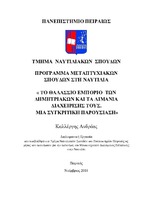Το θαλάσσιο εμπόριο των δημητριακών και τα λιμάνια διαχείρισής τους. Μια συγκριτική παρουσίαση

View/
Keywords
Δημητριακά ; Διεθνές εμπόριο ; Τερματικά διαχείρισης ; Ναυτιλιακή αγοράAbstract
Cereal grains are one of the most important bulk dry cargoes transported by sea all over the world because they serve as a basic food source. They present many peculiarities as goods and also as cargo, so they need special treatment and equipment to move them.
Cereal trade, also presents particularities, since factors such as weather, political instability, protectionism and, of course, international competition determine the quantities and the flows of this type of cargo worldwide. China's growth in particular has led to an increase in world trade over the last few years, and increased demand has shaped the flows of cereals as well as the global supply.
Prices and the relevant economic and maritime indicators have a major impact on the world economy and prosperity. Prices for main cereals vary and are constantly changing globally due to the volatility of the conditions mentioned above, changing the landscape and increasing competition between import and export countries.
Of course, all of this under the prism of the maritime market, which serves the flows and plays a huge role in price formation and ultimately serving the supply and demand. The ports are not only transport centers but an important link in a much larger transport chain for cereal transport. Large cereal management terminals such as Houston in America, Novorossiisk in Russia, Le Havre and Odessa in Europe have been transformed due to the formation of flows and the increase in grain trade at junction stations for the management of this commodity.


